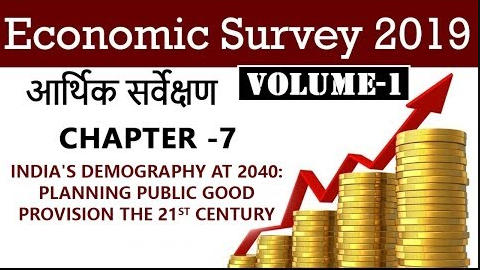Table of Contents


RECENT DEMOGRAPHIC TRENDS
- Population growth in India has been slowing in recent decades from an annual growth rate of 2.5% during 1971-81 to an estimated 1.3% as of 2011-16.


- The main reason for decline in the population growth rate has been the steady decline in India’s total fertility rate (TFR) since the mid-1980s.
- Though the decline in India’s TFR has been more gradual when compared to the experience of other emerging economies, it has nonetheless halved from 4.5 in 1984 to 2.3 as of 2016.


- The replacement level fertility is usually marked at 2.1
- India has reached the current TFR of 2.3 at a relatively low per capita income when compared to the experience of major developed economies but similar to that of other Asian countries.
- There is also a wide variation in the experience of different Indian states. TFR is now below replacement level fertility in 13 out of the 22 major states.


- These developments suggest that India has entered the next stage of demographic transition with population growth set to slow markedly in the next two decades along with a significant increase in the share of working age population (the so-called “demographic dividend” phase).
PROJECTING NATIONAL AND STATE LEVEL POPULATION
(i) Declining Fertility Rates
- Projected values for 2021-41 suggest that TFR at the national level will continue to decline rapidly.
- It will lie below replacement level fertility at 1.8 as early as 2021 and will remain around 1.7 till 2041.
(ii) Population Growth Trajectory
- India’s population growth will continue to slow rapidly over the next two decades, growing less than 1% during 2021-31 and under 0.5% during 2031-41.
- Such population growth rates would be close to the trend currently seen in countries such as Germany and France.
(iii) Changing Age Composition
- India’s population at the national level and in several states will begin ageing significantly in just a decade from now.
- The share of India’s young, i.e. 0-19 years, is projected to drop from as high as 41% in 2011 to 25% by 2041.
- The share of elderly, 60 years and above will double from 8.6% in 2011 to 16% by 2041.
- India’s demographic dividend will peak around 2041, when the share of working-age, i.e. 20-59 years, population is expected to hit 59%.
POLICY IMPLICATIONS OF AGEING
(i) Elementary Schools
- The number of school-going children in India will decline by 18.4% between 2021 and 2041.
- This will have very important social and economic consequences.
- The number of schools per capita will rise significantly in India across all major states even if no more schools are added.

- The time may soon come in many states to consolidate/merge elementary schools in order to keep them viable.
- Schools located within 1-3 kms radius of each other can be chosen for this purpose to ensure no significant change in access.
- This is not about reducing investment in elementary education, but an argument for shifting policy emphasis from quantity towards quality and efficiency of education.
(ii) Health Care Facilities
- Access to health care is still a major challenge in India.
- If India’s hospital facilities remain at current levels, rising population over the next two decades will sharply reduce the per capita availability of hospital beds.


- States with high population growth are also the ones with the lowest per capita availability of hospital beds.
- Hence, there is a straightforward case for expanding medical facilities in these states.

(iii) Retirement Age
- India’s healthy life expectancy at the age of 60, has continually increased over the years for both men and women.
- It stands at 12.9 years (12.5 years for males; 13.3 years for females), though it is still much lower than that for other major developed and emerging economies.

- Due to ageing population and increasing pressure on pension funding, many countries have begun raising the pensionable retirement age.
- Given that life expectancy for both males and females in India is likely to continue rising, increasing the retirement age for both men and women going forward could be considered in line with the experience of other countries.
- This would also help increase female labour force participation in the older age-groups.

CONCLUSION
- This chapter is not merely an attempt to look at the changing population dynamics of the country.
- But is meant as an illustration of how several of the common working assumptions of economists and policymakers need to be revisited from time to time.
- Thus it is important to focus on areas such as urbanization, energy requirements, forest cover, water availability, climate change and other long-term factors that have a large impact on the socio-economic context

Latest Burning Issues | Free PDF






















 WhatsApp
WhatsApp